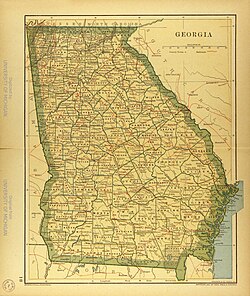
Situated in the heart of the American Southeast, the U.S. state of Georgia has served as a major crossroads of human migration for centuries. From precolonial indigenous settlements to modern international arrivals, waves of diverse populations have shaped the state’s demographic fabric, cultural identity, and economic development. Early European colonization under British rule introduced a steady flow of settlers and forcibly trafficked African laborers, laying the groundwork for Georgia’s plantation-based economy. In the nineteenth century, forced Indigenous removals and expanding agriculture altered population centers and land use across the region. Meanwhile, post–Civil War patterns saw both African Americans leaving during the Great Migration and, eventually, new residents drawn by the state’s emerging industries and urban growth. Today, Georgia’s continued appeal to domestic and global migrants reflects its long-standing role as a nexus of opportunity and cultural exchange.
Research your ancestors on MyHeritage
List of Georgia State historical migration routesList of Georgia State historical migration routes
| Time Period | Ethnic Group | Origination Location | Arrival Location | Motivating Factors |
|---|---|---|---|---|
| Pre-1700 (Pre-Colonial) | Indigenous peoples (e.g. Creek, Cherokee,[1] Chickasaw, Choctaw) | Various regions of the Southeastern Woodlands | Present-day Georgia river valleys and upland areas | Emergence of complex societies, natural resources, trade networks |
| 1730s–1770s (Colonial Era) | English, Scottish, German (Salzburgers), and other European colonists | Primarily from Great Britain and parts of Northern Europe | Savannah and coastal regions of Georgia | Economic opportunities, land grants under the Trustees, religious freedom (e.g. Salzburgers), expansion of British colonies |
| 1730s–1800s (Transatlantic Slave Trade) | Enslaved Africans (various ethnic groups, e.g. Igbo, Akan, Yoruba) | West and Central Africa (via the Caribbean and other colonies) | Plantations and settlements across Georgia | Forced migration through the slave trade, labor demand for rice, indigo, and later cotton plantations |
| 1776–1800 (Early Statehood) | American settlers (English, Scots-Irish, German, etc.) | Surrounding colonies/states (e.g. Virginia, Carolinas) | Central and northern Georgia | Westward expansion, agricultural land opportunities following American independence |
| 1820s–1830s (Indian Removal Era) | Cherokee and other Native American nations | Northern and western Georgia (Cherokee lands) | Forced relocation to Indian Territory (present-day Oklahoma) | Federal and state policies (Indian Removal Act), settler expansion, discovery of gold in Dahlonega |
| 1800–1860 (Antebellum Period) | Plantation owners, yeoman farmers, enslaved African Americans | Southern states (interstate slave trade) and rural eastern areas | Cotton belt regions across Georgia (e.g. Piedmont, Black Belt) | Cotton boom, plantation expansion, profitability of slave labor |
| 1865–1877 (Reconstruction) | Freed African Americans | Plantations and rural Georgia | Remained in or moved across Georgia, some migrated to nearby states | Seeking new economic opportunities, establishment of Freedmen’s communities, sharecropping and tenant farming |
| 1870–1900 (Post-Reconstruction) | White and Black rural populations, some European immigrants | Rural farmlands of Georgia and other Southern states | Emerging industrial/urban centers (Atlanta, Macon, Augusta) | Industrialization, railroad expansion, job opportunities in cities |
| 1910–1930 (Great Migration, First Wave) | African Americans | Rural Georgia (and broader South) | Northern and Midwestern cities (Chicago, Detroit, New York) | Escape from Jim Crow laws, lynching, lack of economic opportunity; pull of industrial jobs in the North |
| 1940s–1960s (WWII & Post-War Boom) | Rural Georgians (Black and White), returning veterans | Small towns and agricultural areas | Growing urban centers (Atlanta, Columbus, Savannah) | Industrial jobs, GI Bill opportunities, suburban development |
| 1970s–1990s (Sunbelt Migration) | Americans from the Northeast, Midwest; African Americans returning South | Rust Belt and Northern states | Atlanta metropolitan area and other booming cities in Georgia | Lower cost of living, warmer climate, economic expansion, corporate relocations (e.g. Coca-Cola, Delta, CNN) |
| 1980s–Present (Recent Immigration) | Latin American (Mexican, Central American), Asian (Korean, Vietnamese, Indian), African, and others | Various global regions (Latin America, Asia, Africa) | Metro Atlanta, Gainesville, Dalton, and other urban/suburban areas | Job opportunities (construction, poultry, carpet industries), family reunification, refugee resettlement, vibrant economic growth |
References
- ↑ Cherokee Indians. New Georgia Encyclopedia

